Fitness Training Prescription for a 40 Year Old Male
VerifiedAdded on 2023/04/08
|15
|1978
|253
AI Summary
This essay provides a fitness training prescription for a 40-year-old male client who wants to lose excess fat, improve fitness level, and get stronger. The prescription includes flexibility and cardiovascular training, neuromotor training, plyometric exercise, and resistance exercises. The essay also discusses interval types and energy systems used in cardiovascular training, as well as HRR calculation based on exercise intensity.
Contribute Materials
Your contribution can guide someone’s learning journey. Share your
documents today.
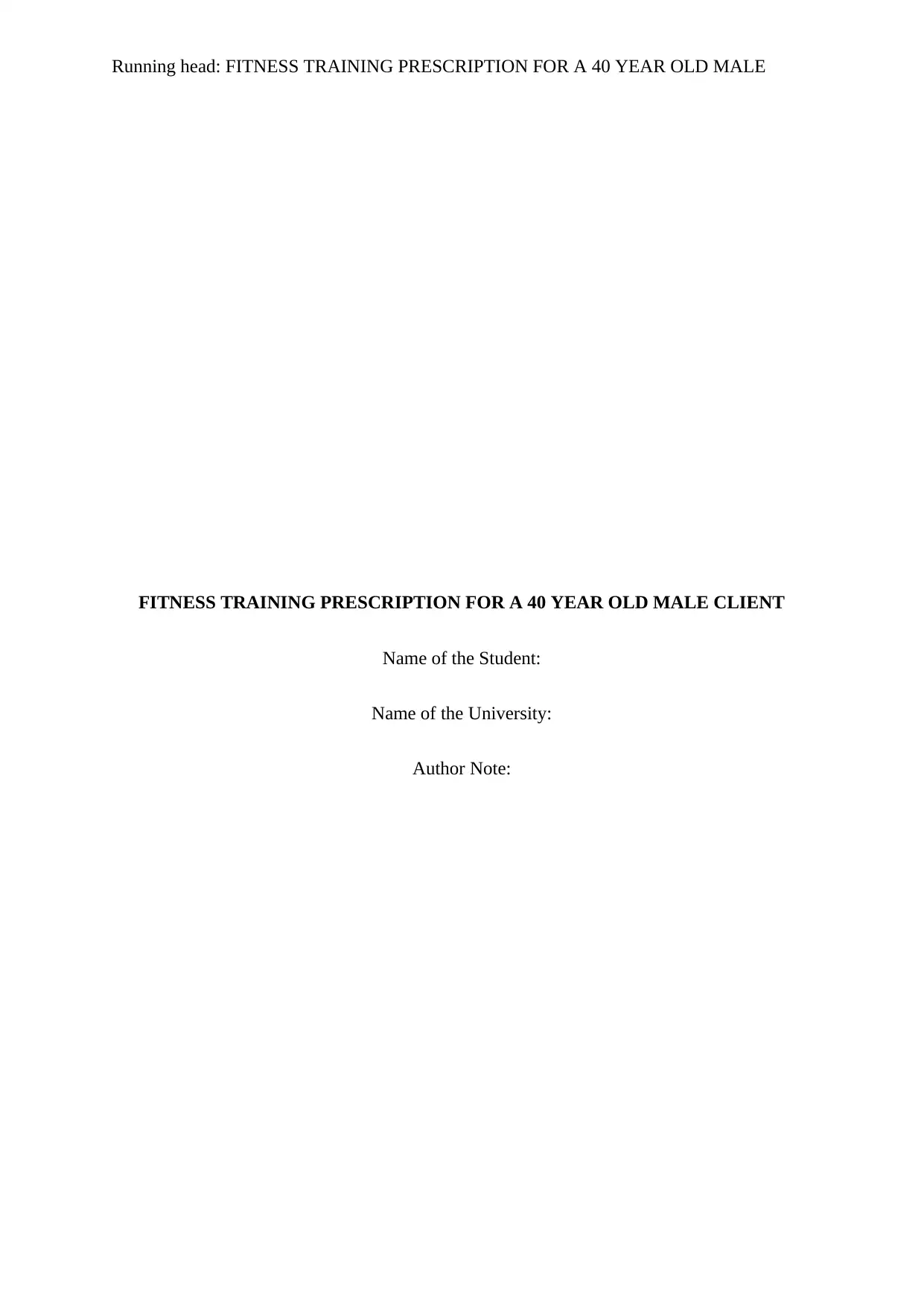
Running head: FITNESS TRAINING PRESCRIPTION FOR A 40 YEAR OLD MALE
FITNESS TRAINING PRESCRIPTION FOR A 40 YEAR OLD MALE CLIENT
Name of the Student:
Name of the University:
Author Note:
FITNESS TRAINING PRESCRIPTION FOR A 40 YEAR OLD MALE CLIENT
Name of the Student:
Name of the University:
Author Note:
Secure Best Marks with AI Grader
Need help grading? Try our AI Grader for instant feedback on your assignments.
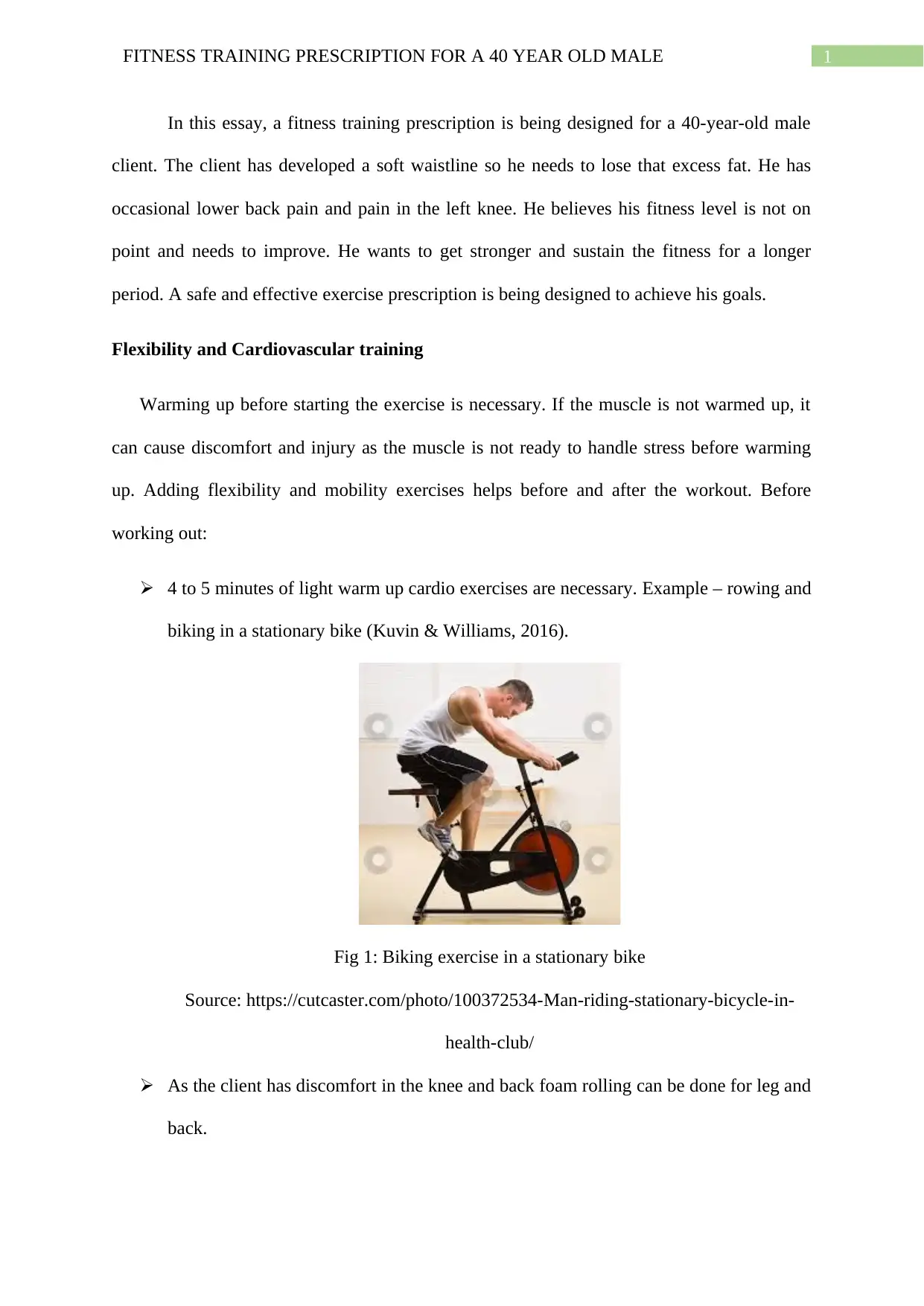
1FITNESS TRAINING PRESCRIPTION FOR A 40 YEAR OLD MALE
In this essay, a fitness training prescription is being designed for a 40-year-old male
client. The client has developed a soft waistline so he needs to lose that excess fat. He has
occasional lower back pain and pain in the left knee. He believes his fitness level is not on
point and needs to improve. He wants to get stronger and sustain the fitness for a longer
period. A safe and effective exercise prescription is being designed to achieve his goals.
Flexibility and Cardiovascular training
Warming up before starting the exercise is necessary. If the muscle is not warmed up, it
can cause discomfort and injury as the muscle is not ready to handle stress before warming
up. Adding flexibility and mobility exercises helps before and after the workout. Before
working out:
4 to 5 minutes of light warm up cardio exercises are necessary. Example – rowing and
biking in a stationary bike (Kuvin & Williams, 2016).
Fig 1: Biking exercise in a stationary bike
Source: https://cutcaster.com/photo/100372534-Man-riding-stationary-bicycle-in-
health-club/
As the client has discomfort in the knee and back foam rolling can be done for leg and
back.
In this essay, a fitness training prescription is being designed for a 40-year-old male
client. The client has developed a soft waistline so he needs to lose that excess fat. He has
occasional lower back pain and pain in the left knee. He believes his fitness level is not on
point and needs to improve. He wants to get stronger and sustain the fitness for a longer
period. A safe and effective exercise prescription is being designed to achieve his goals.
Flexibility and Cardiovascular training
Warming up before starting the exercise is necessary. If the muscle is not warmed up, it
can cause discomfort and injury as the muscle is not ready to handle stress before warming
up. Adding flexibility and mobility exercises helps before and after the workout. Before
working out:
4 to 5 minutes of light warm up cardio exercises are necessary. Example – rowing and
biking in a stationary bike (Kuvin & Williams, 2016).
Fig 1: Biking exercise in a stationary bike
Source: https://cutcaster.com/photo/100372534-Man-riding-stationary-bicycle-in-
health-club/
As the client has discomfort in the knee and back foam rolling can be done for leg and
back.
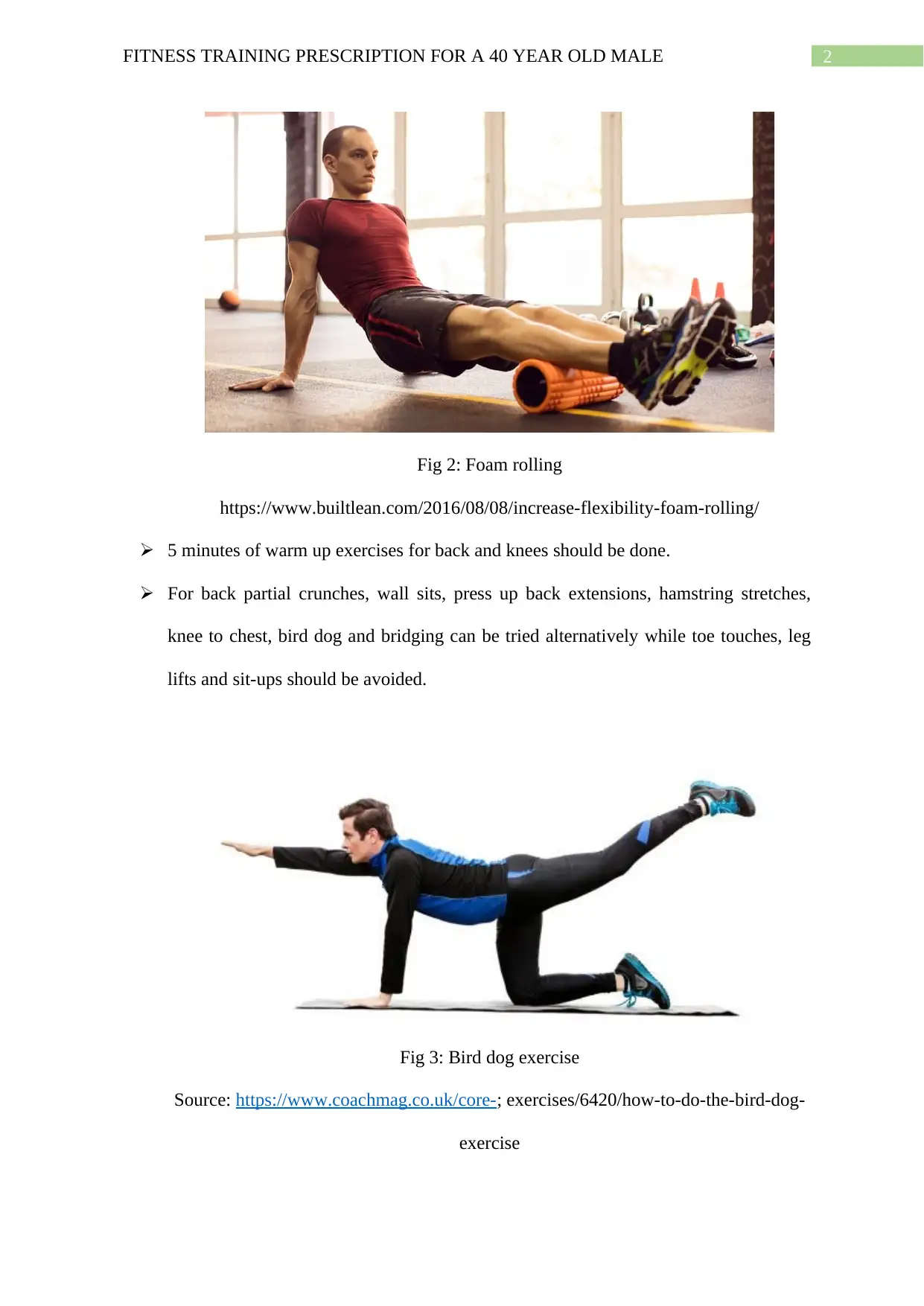
2FITNESS TRAINING PRESCRIPTION FOR A 40 YEAR OLD MALE
Fig 2: Foam rolling
https://www.builtlean.com/2016/08/08/increase-flexibility-foam-rolling/
5 minutes of warm up exercises for back and knees should be done.
For back partial crunches, wall sits, press up back extensions, hamstring stretches,
knee to chest, bird dog and bridging can be tried alternatively while toe touches, leg
lifts and sit-ups should be avoided.
Fig 3: Bird dog exercise
Source: https://www.coachmag.co.uk/core-; exercises/6420/how-to-do-the-bird-dog-
exercise
Fig 2: Foam rolling
https://www.builtlean.com/2016/08/08/increase-flexibility-foam-rolling/
5 minutes of warm up exercises for back and knees should be done.
For back partial crunches, wall sits, press up back extensions, hamstring stretches,
knee to chest, bird dog and bridging can be tried alternatively while toe touches, leg
lifts and sit-ups should be avoided.
Fig 3: Bird dog exercise
Source: https://www.coachmag.co.uk/core-; exercises/6420/how-to-do-the-bird-dog-
exercise
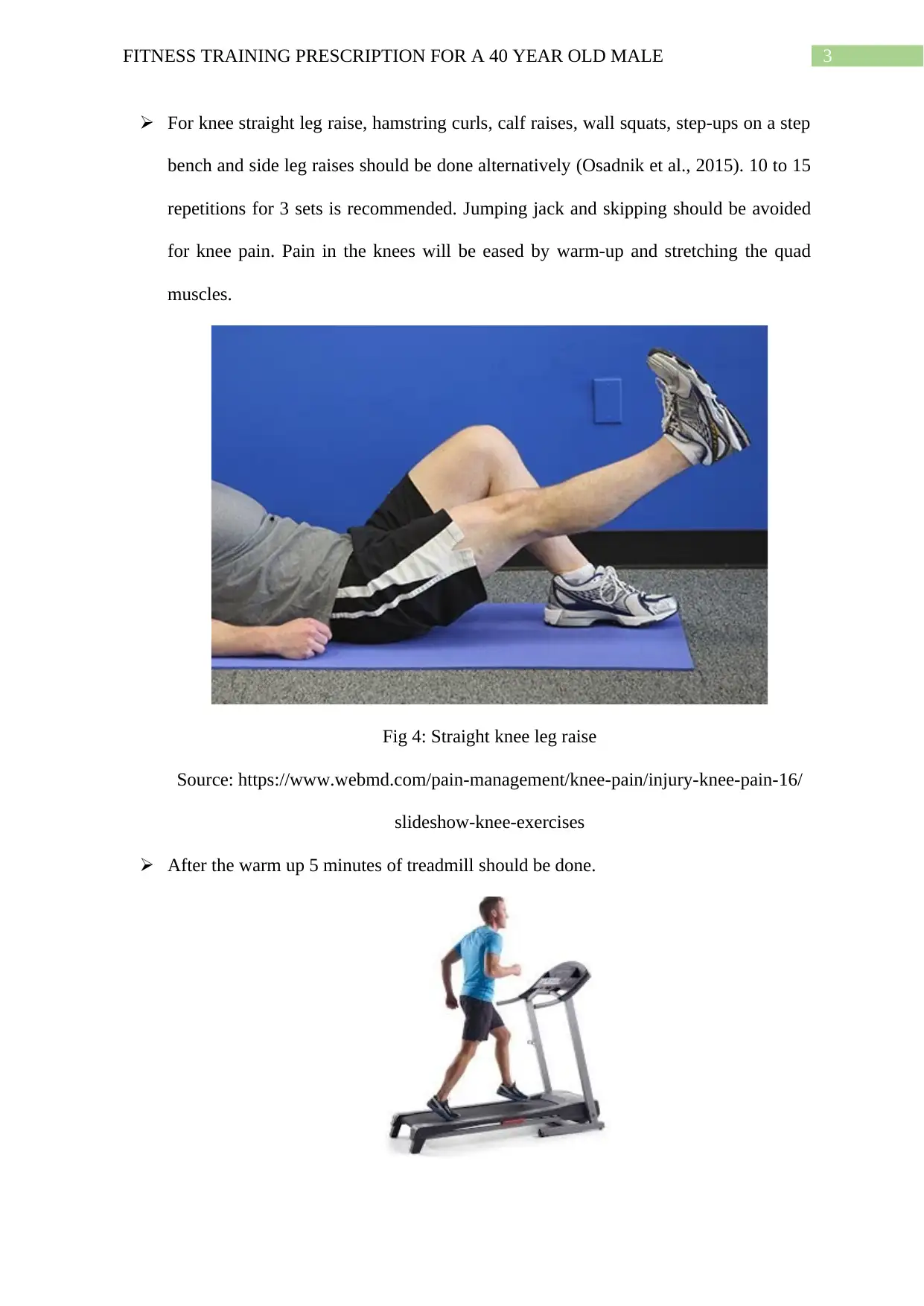
3FITNESS TRAINING PRESCRIPTION FOR A 40 YEAR OLD MALE
For knee straight leg raise, hamstring curls, calf raises, wall squats, step-ups on a step
bench and side leg raises should be done alternatively (Osadnik et al., 2015). 10 to 15
repetitions for 3 sets is recommended. Jumping jack and skipping should be avoided
for knee pain. Pain in the knees will be eased by warm-up and stretching the quad
muscles.
Fig 4: Straight knee leg raise
Source: https://www.webmd.com/pain-management/knee-pain/injury-knee-pain-16/
slideshow-knee-exercises
After the warm up 5 minutes of treadmill should be done.
For knee straight leg raise, hamstring curls, calf raises, wall squats, step-ups on a step
bench and side leg raises should be done alternatively (Osadnik et al., 2015). 10 to 15
repetitions for 3 sets is recommended. Jumping jack and skipping should be avoided
for knee pain. Pain in the knees will be eased by warm-up and stretching the quad
muscles.
Fig 4: Straight knee leg raise
Source: https://www.webmd.com/pain-management/knee-pain/injury-knee-pain-16/
slideshow-knee-exercises
After the warm up 5 minutes of treadmill should be done.
Secure Best Marks with AI Grader
Need help grading? Try our AI Grader for instant feedback on your assignments.
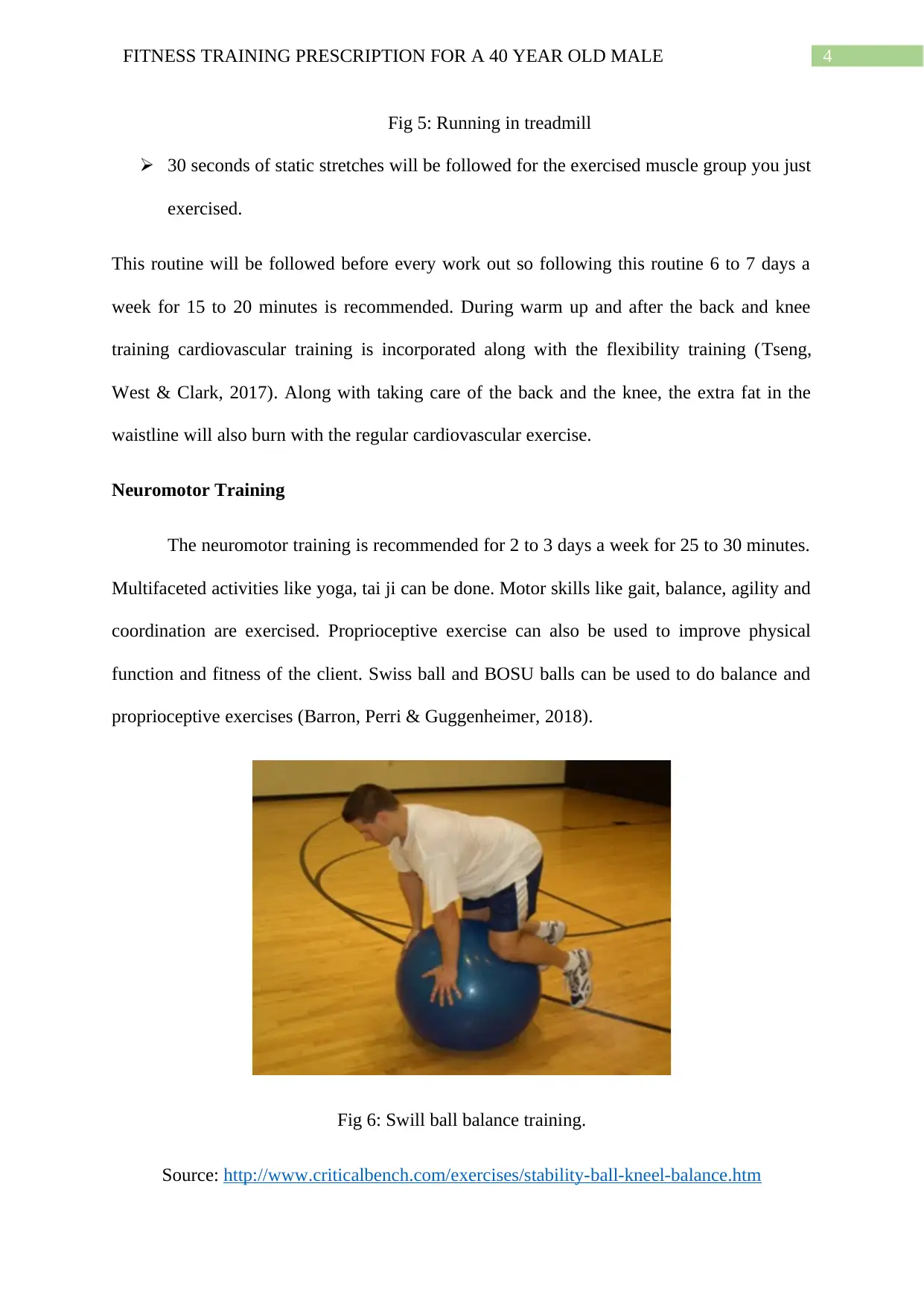
4FITNESS TRAINING PRESCRIPTION FOR A 40 YEAR OLD MALE
Fig 5: Running in treadmill
30 seconds of static stretches will be followed for the exercised muscle group you just
exercised.
This routine will be followed before every work out so following this routine 6 to 7 days a
week for 15 to 20 minutes is recommended. During warm up and after the back and knee
training cardiovascular training is incorporated along with the flexibility training (Tseng,
West & Clark, 2017). Along with taking care of the back and the knee, the extra fat in the
waistline will also burn with the regular cardiovascular exercise.
Neuromotor Training
The neuromotor training is recommended for 2 to 3 days a week for 25 to 30 minutes.
Multifaceted activities like yoga, tai ji can be done. Motor skills like gait, balance, agility and
coordination are exercised. Proprioceptive exercise can also be used to improve physical
function and fitness of the client. Swiss ball and BOSU balls can be used to do balance and
proprioceptive exercises (Barron, Perri & Guggenheimer, 2018).
Fig 6: Swill ball balance training.
Source: http://www.criticalbench.com/exercises/stability-ball-kneel-balance.htm
Fig 5: Running in treadmill
30 seconds of static stretches will be followed for the exercised muscle group you just
exercised.
This routine will be followed before every work out so following this routine 6 to 7 days a
week for 15 to 20 minutes is recommended. During warm up and after the back and knee
training cardiovascular training is incorporated along with the flexibility training (Tseng,
West & Clark, 2017). Along with taking care of the back and the knee, the extra fat in the
waistline will also burn with the regular cardiovascular exercise.
Neuromotor Training
The neuromotor training is recommended for 2 to 3 days a week for 25 to 30 minutes.
Multifaceted activities like yoga, tai ji can be done. Motor skills like gait, balance, agility and
coordination are exercised. Proprioceptive exercise can also be used to improve physical
function and fitness of the client. Swiss ball and BOSU balls can be used to do balance and
proprioceptive exercises (Barron, Perri & Guggenheimer, 2018).
Fig 6: Swill ball balance training.
Source: http://www.criticalbench.com/exercises/stability-ball-kneel-balance.htm
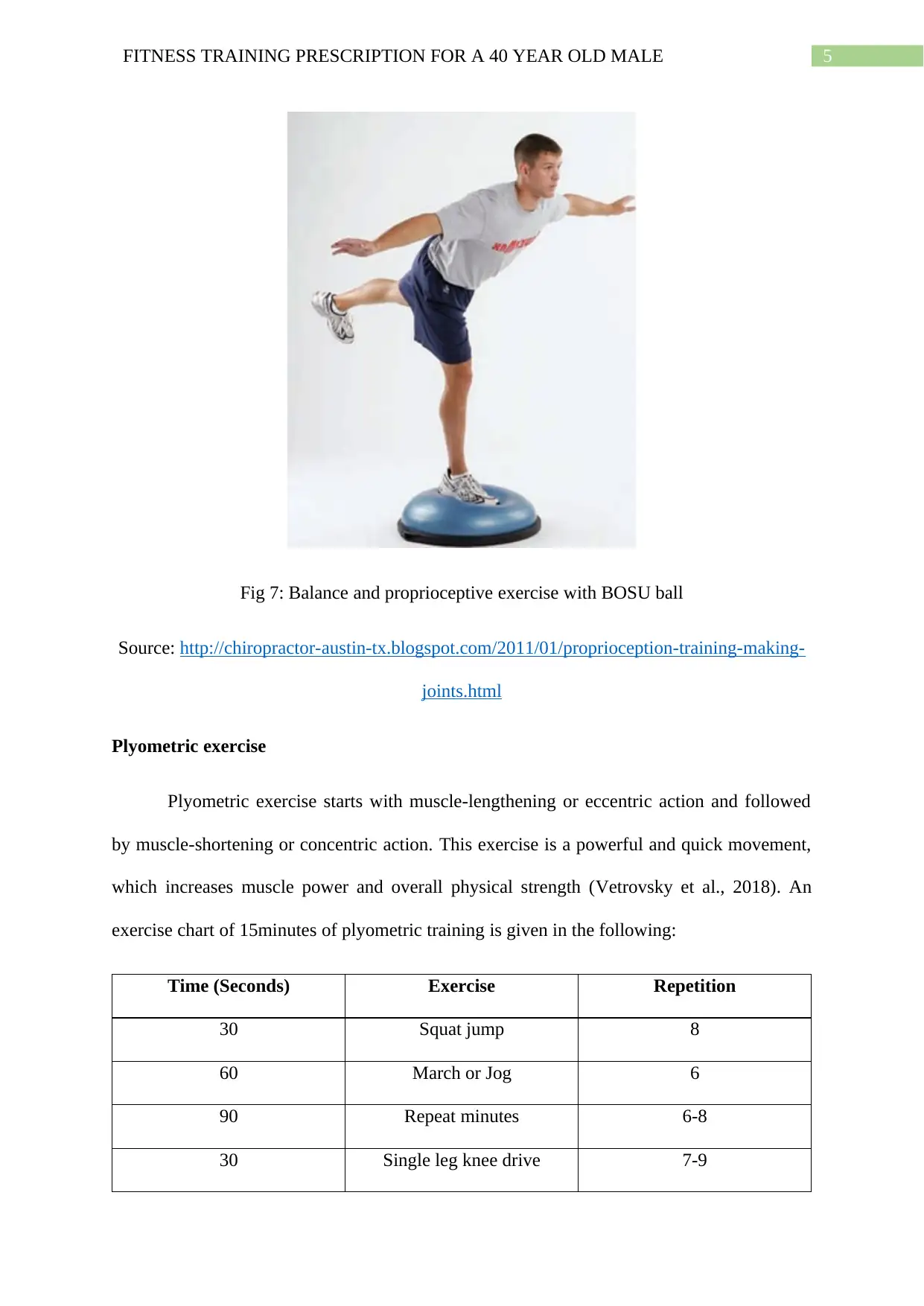
5FITNESS TRAINING PRESCRIPTION FOR A 40 YEAR OLD MALE
Fig 7: Balance and proprioceptive exercise with BOSU ball
Source: http://chiropractor-austin-tx.blogspot.com/2011/01/proprioception-training-making-
joints.html
Plyometric exercise
Plyometric exercise starts with muscle-lengthening or eccentric action and followed
by muscle-shortening or concentric action. This exercise is a powerful and quick movement,
which increases muscle power and overall physical strength (Vetrovsky et al., 2018). An
exercise chart of 15minutes of plyometric training is given in the following:
Time (Seconds) Exercise Repetition
30 Squat jump 8
60 March or Jog 6
90 Repeat minutes 6-8
30 Single leg knee drive 7-9
Fig 7: Balance and proprioceptive exercise with BOSU ball
Source: http://chiropractor-austin-tx.blogspot.com/2011/01/proprioception-training-making-
joints.html
Plyometric exercise
Plyometric exercise starts with muscle-lengthening or eccentric action and followed
by muscle-shortening or concentric action. This exercise is a powerful and quick movement,
which increases muscle power and overall physical strength (Vetrovsky et al., 2018). An
exercise chart of 15minutes of plyometric training is given in the following:
Time (Seconds) Exercise Repetition
30 Squat jump 8
60 March or Jog 6
90 Repeat minutes 6-8
30 Single leg knee drive 7-9
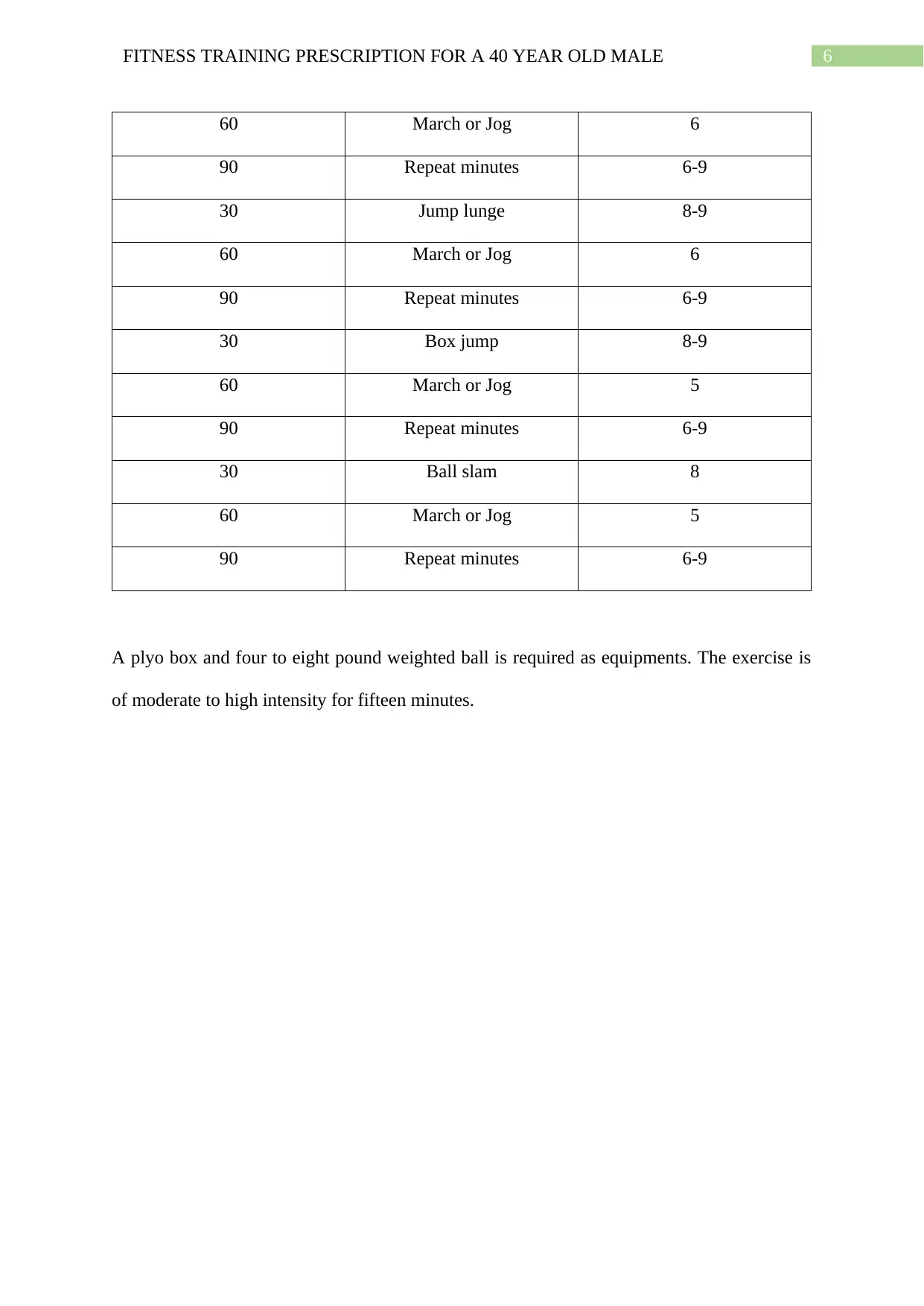
6FITNESS TRAINING PRESCRIPTION FOR A 40 YEAR OLD MALE
60 March or Jog 6
90 Repeat minutes 6-9
30 Jump lunge 8-9
60 March or Jog 6
90 Repeat minutes 6-9
30 Box jump 8-9
60 March or Jog 5
90 Repeat minutes 6-9
30 Ball slam 8
60 March or Jog 5
90 Repeat minutes 6-9
A plyo box and four to eight pound weighted ball is required as equipments. The exercise is
of moderate to high intensity for fifteen minutes.
60 March or Jog 6
90 Repeat minutes 6-9
30 Jump lunge 8-9
60 March or Jog 6
90 Repeat minutes 6-9
30 Box jump 8-9
60 March or Jog 5
90 Repeat minutes 6-9
30 Ball slam 8
60 March or Jog 5
90 Repeat minutes 6-9
A plyo box and four to eight pound weighted ball is required as equipments. The exercise is
of moderate to high intensity for fifteen minutes.
Paraphrase This Document
Need a fresh take? Get an instant paraphrase of this document with our AI Paraphraser
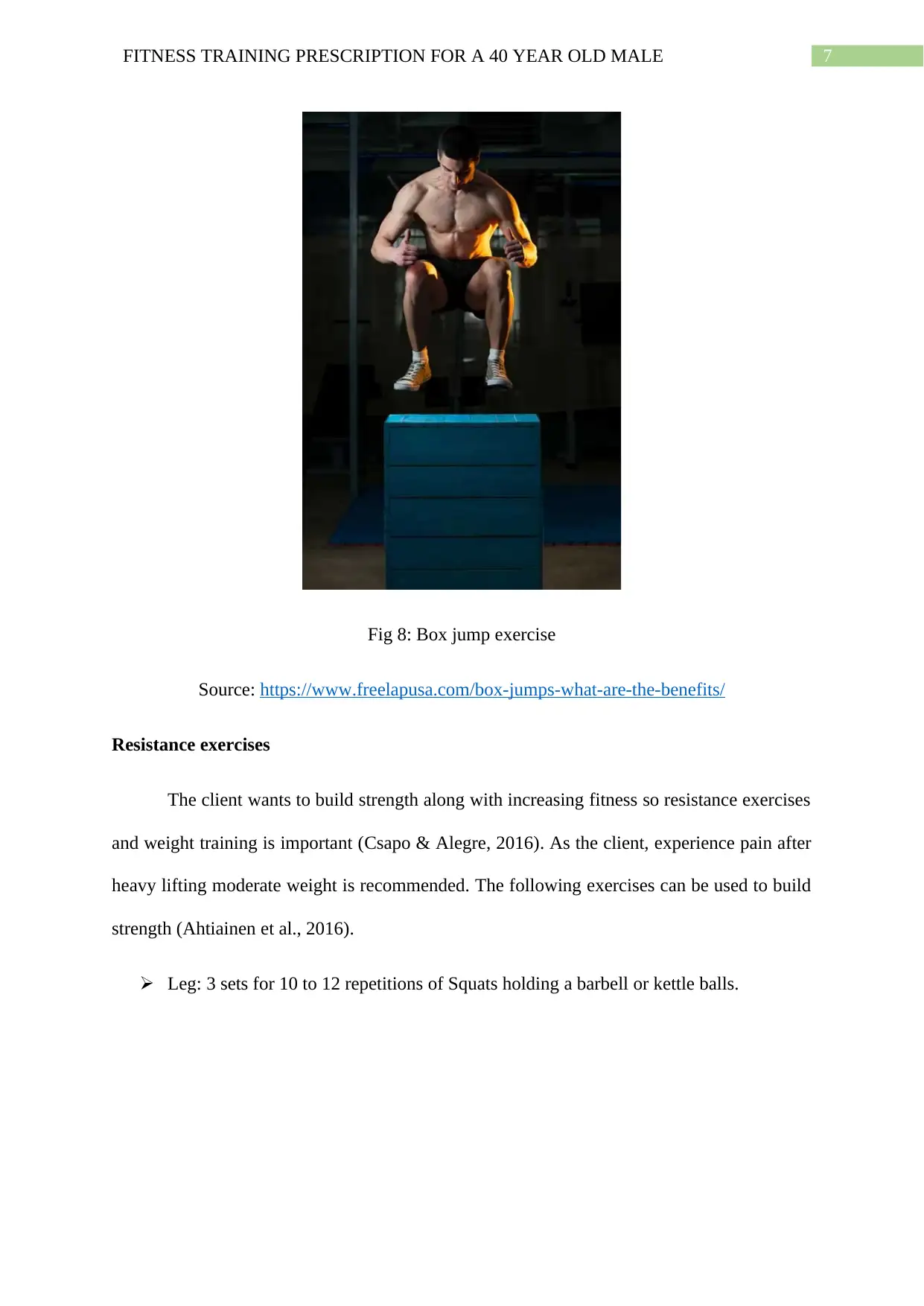
7FITNESS TRAINING PRESCRIPTION FOR A 40 YEAR OLD MALE
Fig 8: Box jump exercise
Source: https://www.freelapusa.com/box-jumps-what-are-the-benefits/
Resistance exercises
The client wants to build strength along with increasing fitness so resistance exercises
and weight training is important (Csapo & Alegre, 2016). As the client, experience pain after
heavy lifting moderate weight is recommended. The following exercises can be used to build
strength (Ahtiainen et al., 2016).
Leg: 3 sets for 10 to 12 repetitions of Squats holding a barbell or kettle balls.
Fig 8: Box jump exercise
Source: https://www.freelapusa.com/box-jumps-what-are-the-benefits/
Resistance exercises
The client wants to build strength along with increasing fitness so resistance exercises
and weight training is important (Csapo & Alegre, 2016). As the client, experience pain after
heavy lifting moderate weight is recommended. The following exercises can be used to build
strength (Ahtiainen et al., 2016).
Leg: 3 sets for 10 to 12 repetitions of Squats holding a barbell or kettle balls.
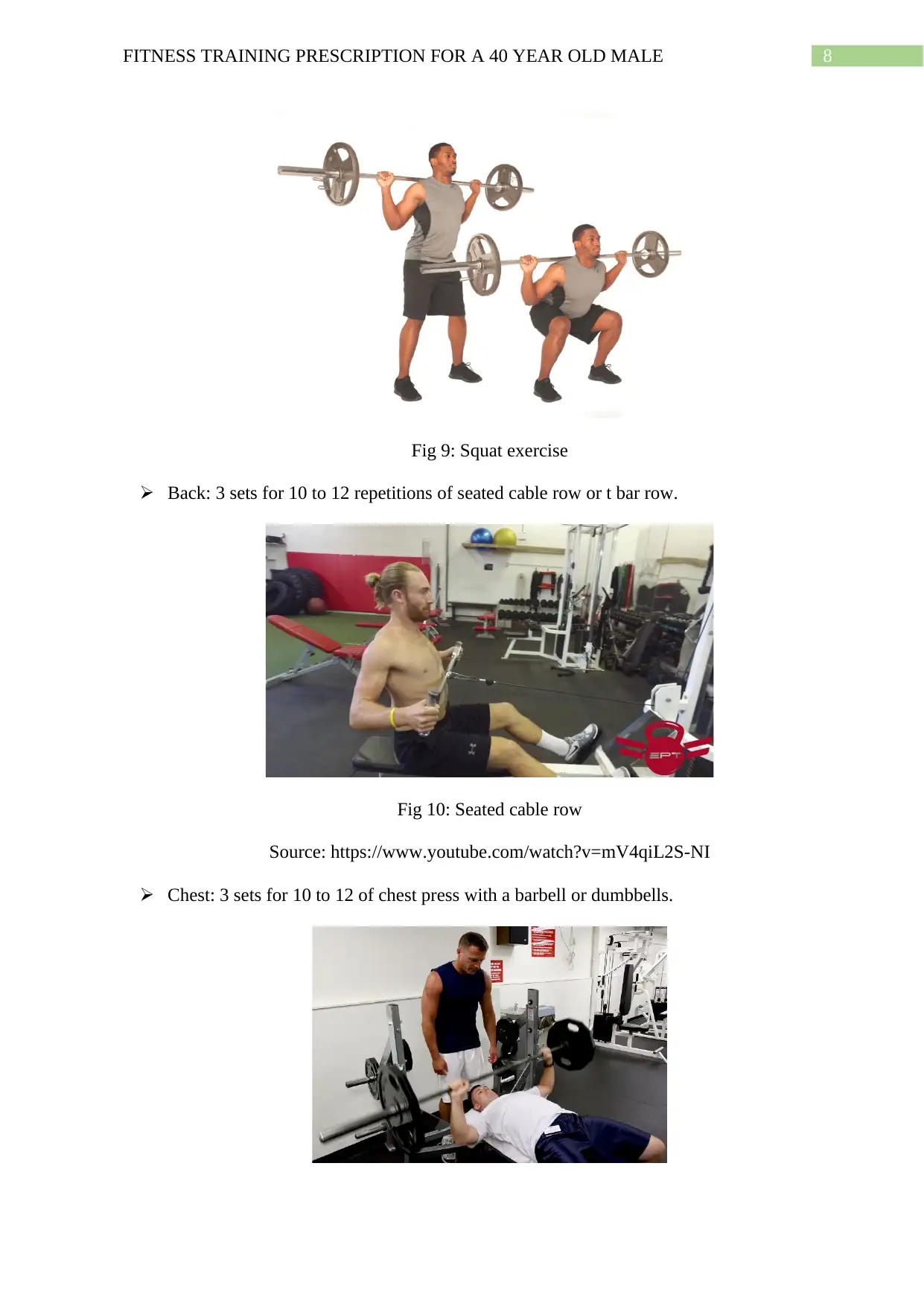
8FITNESS TRAINING PRESCRIPTION FOR A 40 YEAR OLD MALE
Fig 9: Squat exercise
Back: 3 sets for 10 to 12 repetitions of seated cable row or t bar row.
Fig 10: Seated cable row
Source: https://www.youtube.com/watch?v=mV4qiL2S-NI
Chest: 3 sets for 10 to 12 of chest press with a barbell or dumbbells.
Fig 9: Squat exercise
Back: 3 sets for 10 to 12 repetitions of seated cable row or t bar row.
Fig 10: Seated cable row
Source: https://www.youtube.com/watch?v=mV4qiL2S-NI
Chest: 3 sets for 10 to 12 of chest press with a barbell or dumbbells.
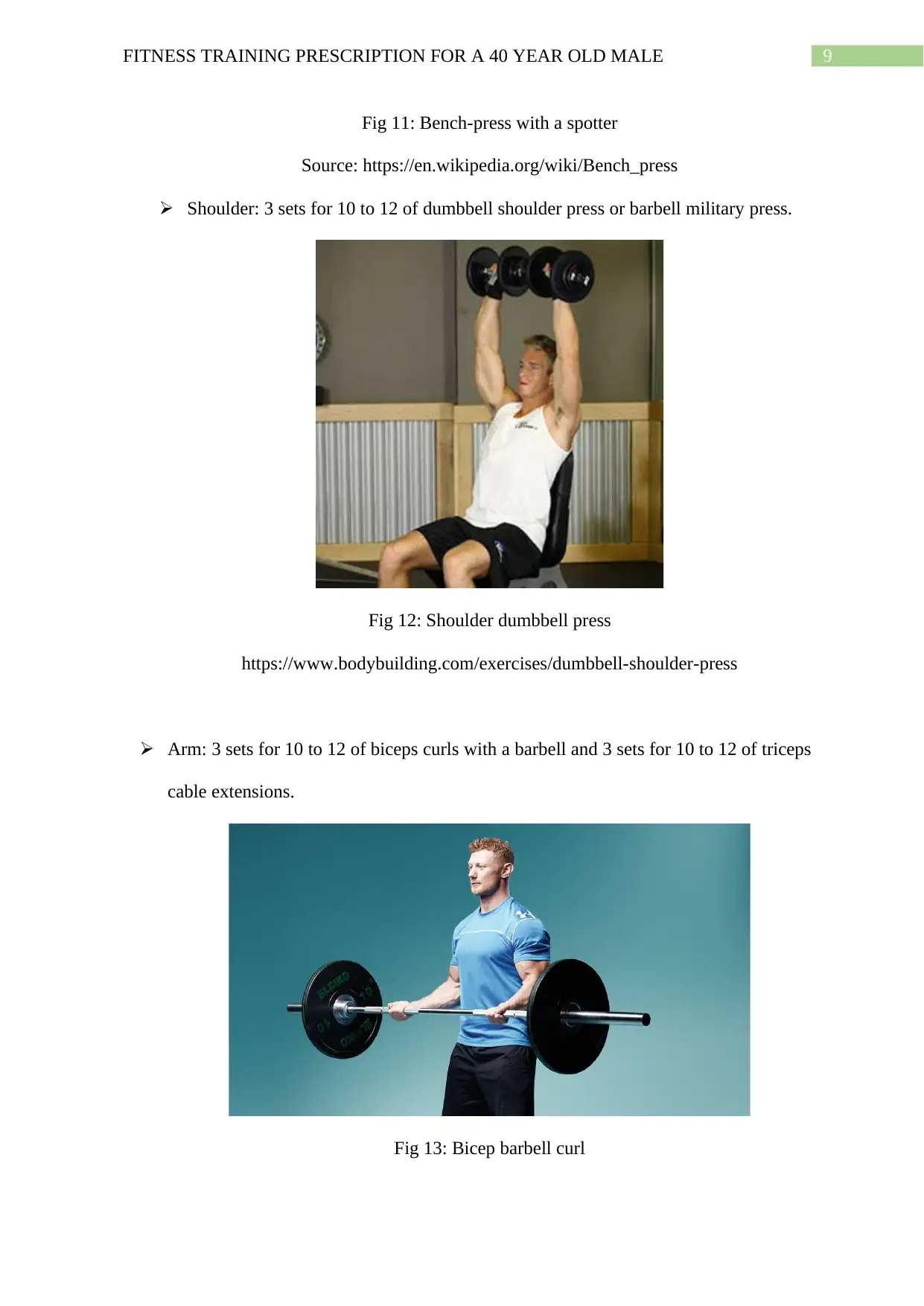
9FITNESS TRAINING PRESCRIPTION FOR A 40 YEAR OLD MALE
Fig 11: Bench-press with a spotter
Source: https://en.wikipedia.org/wiki/Bench_press
Shoulder: 3 sets for 10 to 12 of dumbbell shoulder press or barbell military press.
Fig 12: Shoulder dumbbell press
https://www.bodybuilding.com/exercises/dumbbell-shoulder-press
Arm: 3 sets for 10 to 12 of biceps curls with a barbell and 3 sets for 10 to 12 of triceps
cable extensions.
Fig 13: Bicep barbell curl
Fig 11: Bench-press with a spotter
Source: https://en.wikipedia.org/wiki/Bench_press
Shoulder: 3 sets for 10 to 12 of dumbbell shoulder press or barbell military press.
Fig 12: Shoulder dumbbell press
https://www.bodybuilding.com/exercises/dumbbell-shoulder-press
Arm: 3 sets for 10 to 12 of biceps curls with a barbell and 3 sets for 10 to 12 of triceps
cable extensions.
Fig 13: Bicep barbell curl
Secure Best Marks with AI Grader
Need help grading? Try our AI Grader for instant feedback on your assignments.
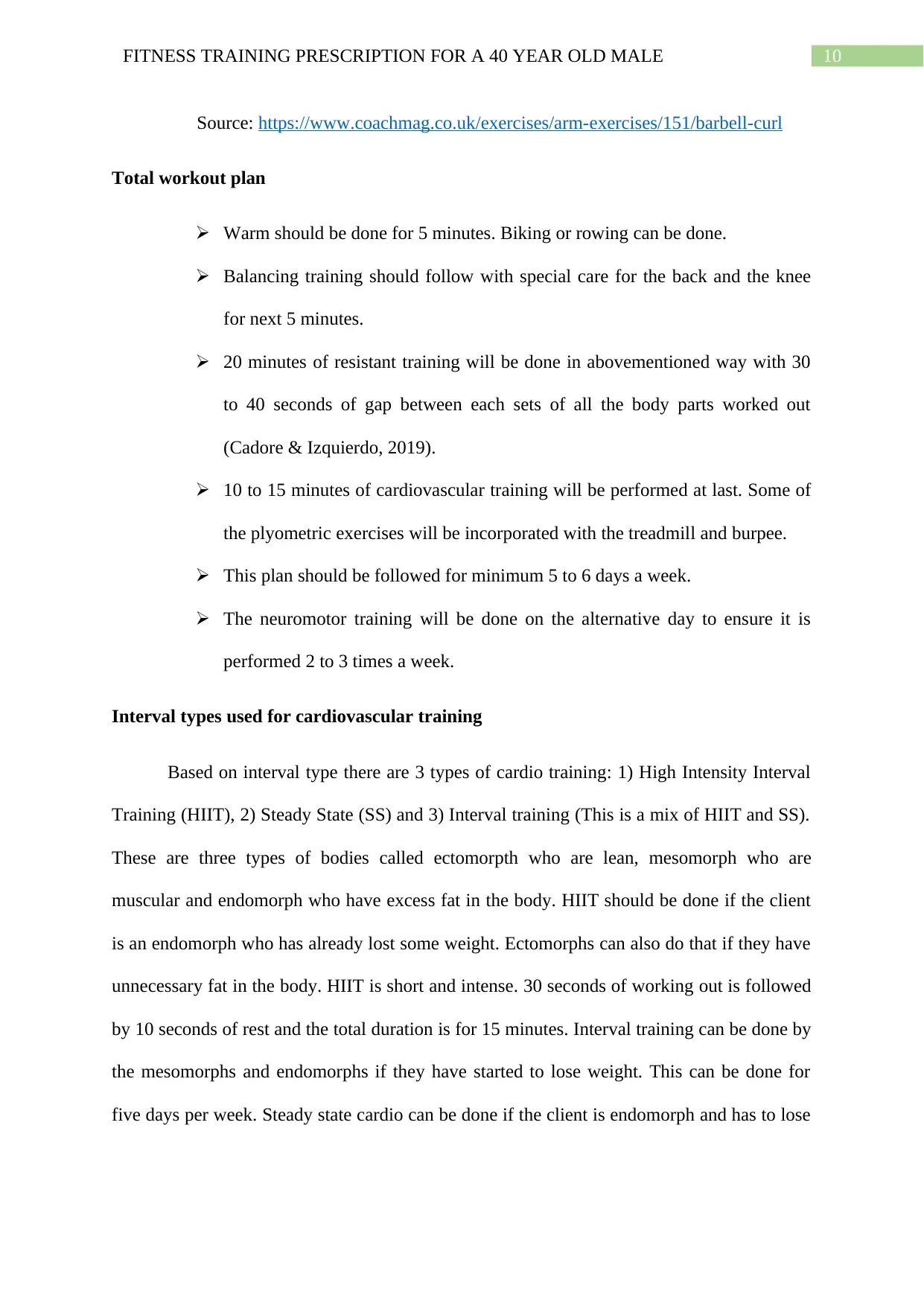
10FITNESS TRAINING PRESCRIPTION FOR A 40 YEAR OLD MALE
Source: https://www.coachmag.co.uk/exercises/arm-exercises/151/barbell-curl
Total workout plan
Warm should be done for 5 minutes. Biking or rowing can be done.
Balancing training should follow with special care for the back and the knee
for next 5 minutes.
20 minutes of resistant training will be done in abovementioned way with 30
to 40 seconds of gap between each sets of all the body parts worked out
(Cadore & Izquierdo, 2019).
10 to 15 minutes of cardiovascular training will be performed at last. Some of
the plyometric exercises will be incorporated with the treadmill and burpee.
This plan should be followed for minimum 5 to 6 days a week.
The neuromotor training will be done on the alternative day to ensure it is
performed 2 to 3 times a week.
Interval types used for cardiovascular training
Based on interval type there are 3 types of cardio training: 1) High Intensity Interval
Training (HIIT), 2) Steady State (SS) and 3) Interval training (This is a mix of HIIT and SS).
These are three types of bodies called ectomorpth who are lean, mesomorph who are
muscular and endomorph who have excess fat in the body. HIIT should be done if the client
is an endomorph who has already lost some weight. Ectomorphs can also do that if they have
unnecessary fat in the body. HIIT is short and intense. 30 seconds of working out is followed
by 10 seconds of rest and the total duration is for 15 minutes. Interval training can be done by
the mesomorphs and endomorphs if they have started to lose weight. This can be done for
five days per week. Steady state cardio can be done if the client is endomorph and has to lose
Source: https://www.coachmag.co.uk/exercises/arm-exercises/151/barbell-curl
Total workout plan
Warm should be done for 5 minutes. Biking or rowing can be done.
Balancing training should follow with special care for the back and the knee
for next 5 minutes.
20 minutes of resistant training will be done in abovementioned way with 30
to 40 seconds of gap between each sets of all the body parts worked out
(Cadore & Izquierdo, 2019).
10 to 15 minutes of cardiovascular training will be performed at last. Some of
the plyometric exercises will be incorporated with the treadmill and burpee.
This plan should be followed for minimum 5 to 6 days a week.
The neuromotor training will be done on the alternative day to ensure it is
performed 2 to 3 times a week.
Interval types used for cardiovascular training
Based on interval type there are 3 types of cardio training: 1) High Intensity Interval
Training (HIIT), 2) Steady State (SS) and 3) Interval training (This is a mix of HIIT and SS).
These are three types of bodies called ectomorpth who are lean, mesomorph who are
muscular and endomorph who have excess fat in the body. HIIT should be done if the client
is an endomorph who has already lost some weight. Ectomorphs can also do that if they have
unnecessary fat in the body. HIIT is short and intense. 30 seconds of working out is followed
by 10 seconds of rest and the total duration is for 15 minutes. Interval training can be done by
the mesomorphs and endomorphs if they have started to lose weight. This can be done for
five days per week. Steady state cardio can be done if the client is endomorph and has to lose
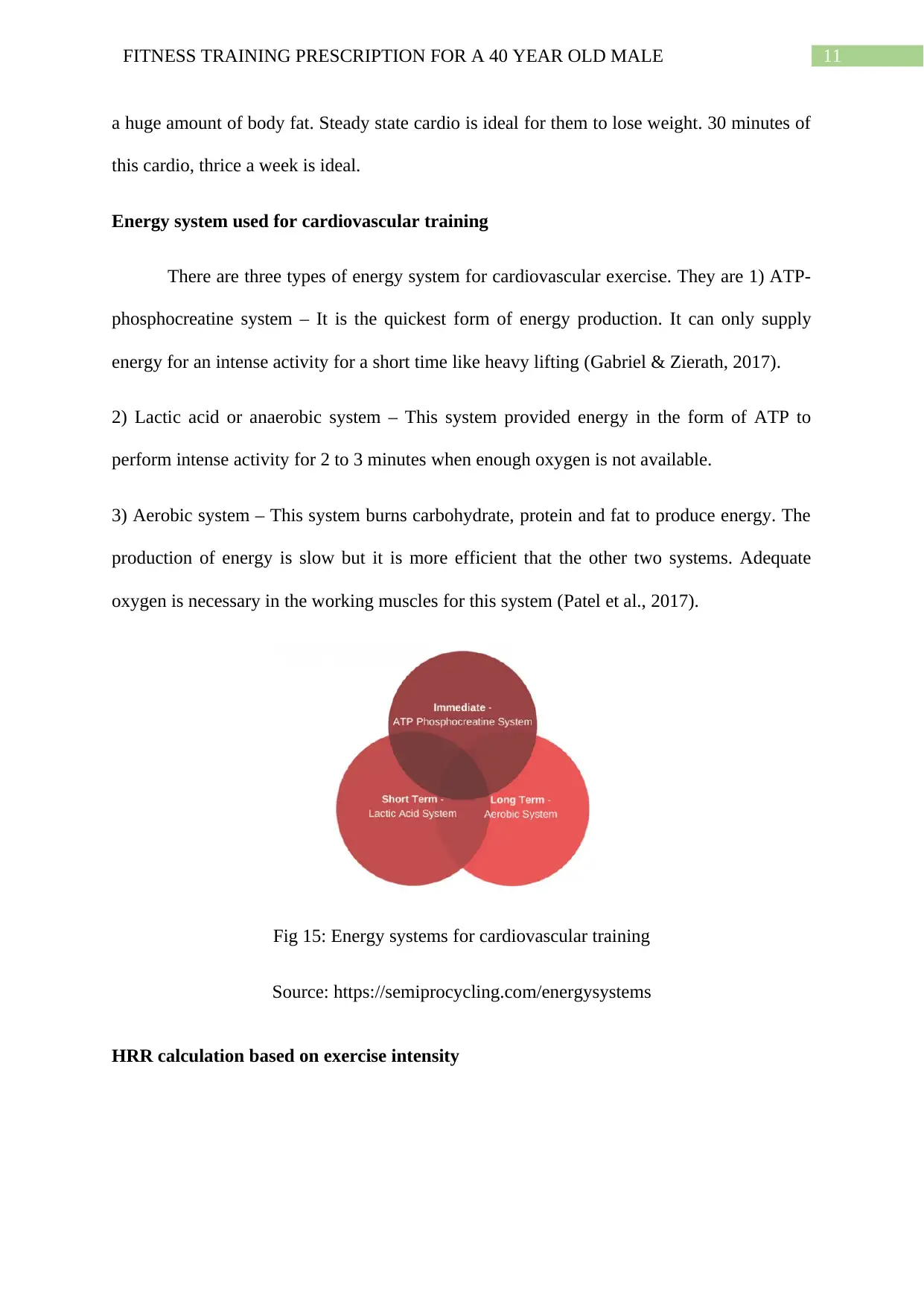
11FITNESS TRAINING PRESCRIPTION FOR A 40 YEAR OLD MALE
a huge amount of body fat. Steady state cardio is ideal for them to lose weight. 30 minutes of
this cardio, thrice a week is ideal.
Energy system used for cardiovascular training
There are three types of energy system for cardiovascular exercise. They are 1) ATP-
phosphocreatine system – It is the quickest form of energy production. It can only supply
energy for an intense activity for a short time like heavy lifting (Gabriel & Zierath, 2017).
2) Lactic acid or anaerobic system – This system provided energy in the form of ATP to
perform intense activity for 2 to 3 minutes when enough oxygen is not available.
3) Aerobic system – This system burns carbohydrate, protein and fat to produce energy. The
production of energy is slow but it is more efficient that the other two systems. Adequate
oxygen is necessary in the working muscles for this system (Patel et al., 2017).
Fig 15: Energy systems for cardiovascular training
Source: https://semiprocycling.com/energysystems
HRR calculation based on exercise intensity
a huge amount of body fat. Steady state cardio is ideal for them to lose weight. 30 minutes of
this cardio, thrice a week is ideal.
Energy system used for cardiovascular training
There are three types of energy system for cardiovascular exercise. They are 1) ATP-
phosphocreatine system – It is the quickest form of energy production. It can only supply
energy for an intense activity for a short time like heavy lifting (Gabriel & Zierath, 2017).
2) Lactic acid or anaerobic system – This system provided energy in the form of ATP to
perform intense activity for 2 to 3 minutes when enough oxygen is not available.
3) Aerobic system – This system burns carbohydrate, protein and fat to produce energy. The
production of energy is slow but it is more efficient that the other two systems. Adequate
oxygen is necessary in the working muscles for this system (Patel et al., 2017).
Fig 15: Energy systems for cardiovascular training
Source: https://semiprocycling.com/energysystems
HRR calculation based on exercise intensity
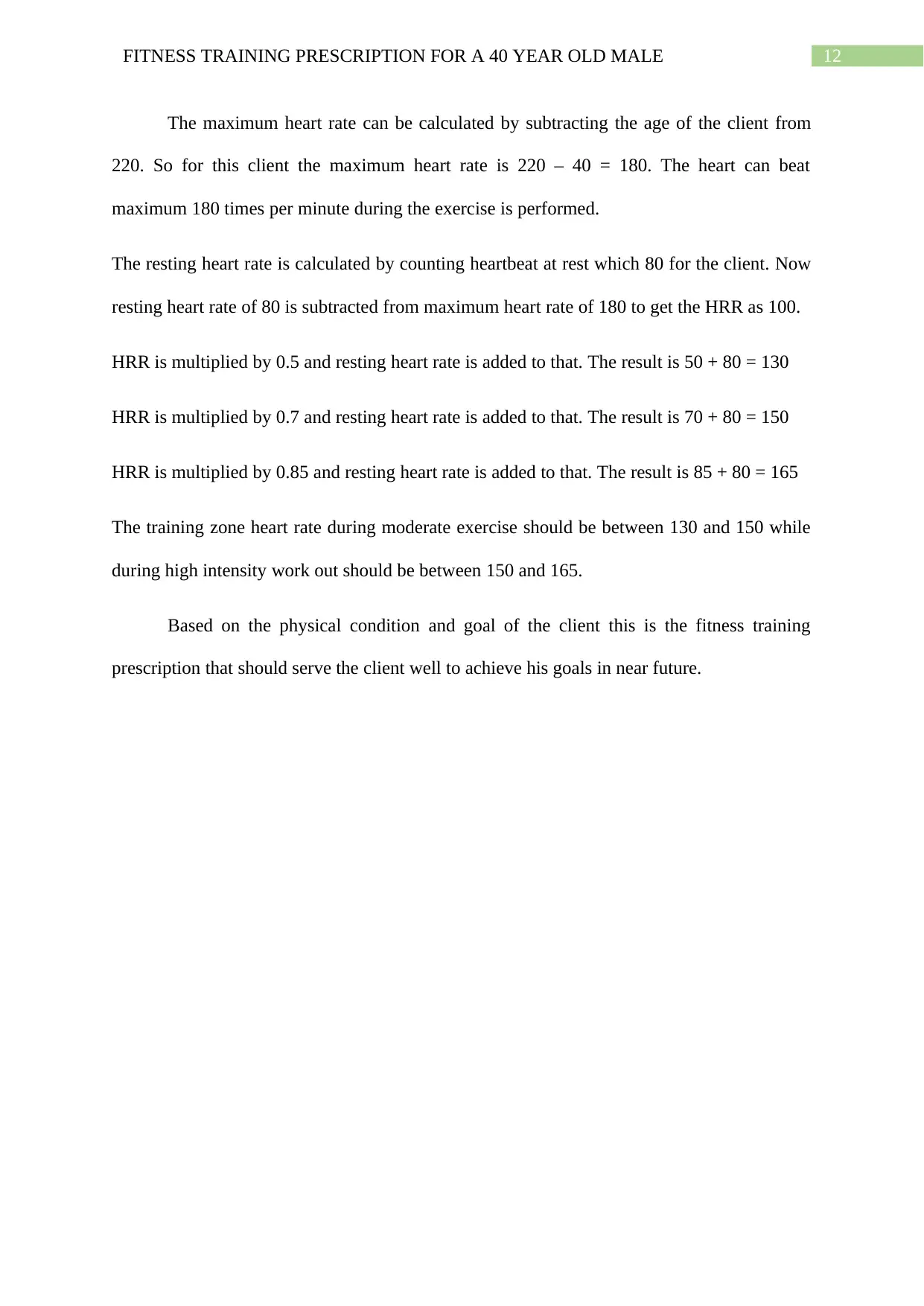
12FITNESS TRAINING PRESCRIPTION FOR A 40 YEAR OLD MALE
The maximum heart rate can be calculated by subtracting the age of the client from
220. So for this client the maximum heart rate is 220 – 40 = 180. The heart can beat
maximum 180 times per minute during the exercise is performed.
The resting heart rate is calculated by counting heartbeat at rest which 80 for the client. Now
resting heart rate of 80 is subtracted from maximum heart rate of 180 to get the HRR as 100.
HRR is multiplied by 0.5 and resting heart rate is added to that. The result is 50 + 80 = 130
HRR is multiplied by 0.7 and resting heart rate is added to that. The result is 70 + 80 = 150
HRR is multiplied by 0.85 and resting heart rate is added to that. The result is 85 + 80 = 165
The training zone heart rate during moderate exercise should be between 130 and 150 while
during high intensity work out should be between 150 and 165.
Based on the physical condition and goal of the client this is the fitness training
prescription that should serve the client well to achieve his goals in near future.
The maximum heart rate can be calculated by subtracting the age of the client from
220. So for this client the maximum heart rate is 220 – 40 = 180. The heart can beat
maximum 180 times per minute during the exercise is performed.
The resting heart rate is calculated by counting heartbeat at rest which 80 for the client. Now
resting heart rate of 80 is subtracted from maximum heart rate of 180 to get the HRR as 100.
HRR is multiplied by 0.5 and resting heart rate is added to that. The result is 50 + 80 = 130
HRR is multiplied by 0.7 and resting heart rate is added to that. The result is 70 + 80 = 150
HRR is multiplied by 0.85 and resting heart rate is added to that. The result is 85 + 80 = 165
The training zone heart rate during moderate exercise should be between 130 and 150 while
during high intensity work out should be between 150 and 165.
Based on the physical condition and goal of the client this is the fitness training
prescription that should serve the client well to achieve his goals in near future.
Paraphrase This Document
Need a fresh take? Get an instant paraphrase of this document with our AI Paraphraser
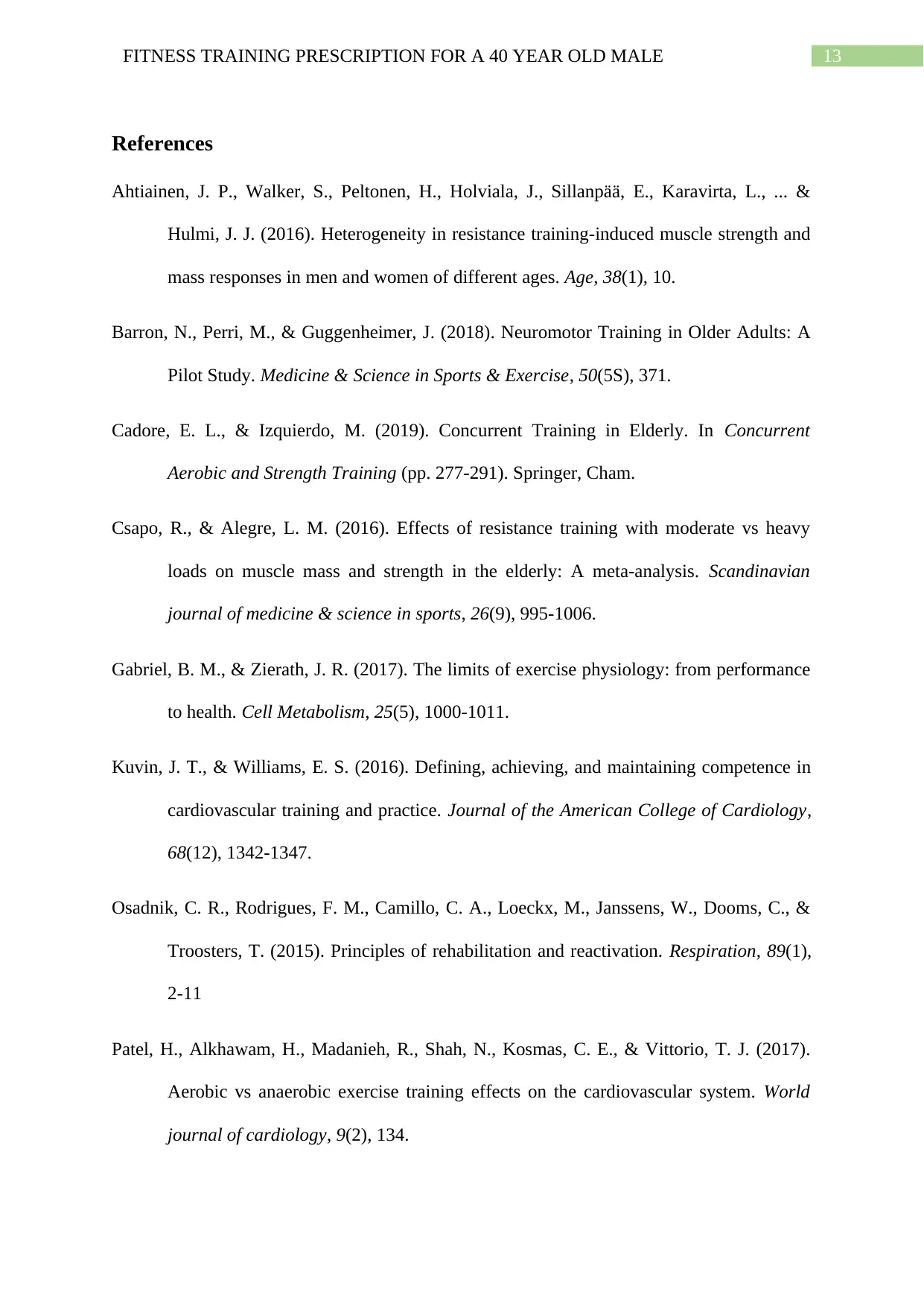
13FITNESS TRAINING PRESCRIPTION FOR A 40 YEAR OLD MALE
References
Ahtiainen, J. P., Walker, S., Peltonen, H., Holviala, J., Sillanpää, E., Karavirta, L., ... &
Hulmi, J. J. (2016). Heterogeneity in resistance training-induced muscle strength and
mass responses in men and women of different ages. Age, 38(1), 10.
Barron, N., Perri, M., & Guggenheimer, J. (2018). Neuromotor Training in Older Adults: A
Pilot Study. Medicine & Science in Sports & Exercise, 50(5S), 371.
Cadore, E. L., & Izquierdo, M. (2019). Concurrent Training in Elderly. In Concurrent
Aerobic and Strength Training (pp. 277-291). Springer, Cham.
Csapo, R., & Alegre, L. M. (2016). Effects of resistance training with moderate vs heavy
loads on muscle mass and strength in the elderly: A meta‐analysis. Scandinavian
journal of medicine & science in sports, 26(9), 995-1006.
Gabriel, B. M., & Zierath, J. R. (2017). The limits of exercise physiology: from performance
to health. Cell Metabolism, 25(5), 1000-1011.
Kuvin, J. T., & Williams, E. S. (2016). Defining, achieving, and maintaining competence in
cardiovascular training and practice. Journal of the American College of Cardiology,
68(12), 1342-1347.
Osadnik, C. R., Rodrigues, F. M., Camillo, C. A., Loeckx, M., Janssens, W., Dooms, C., &
Troosters, T. (2015). Principles of rehabilitation and reactivation. Respiration, 89(1),
2-11
Patel, H., Alkhawam, H., Madanieh, R., Shah, N., Kosmas, C. E., & Vittorio, T. J. (2017).
Aerobic vs anaerobic exercise training effects on the cardiovascular system. World
journal of cardiology, 9(2), 134.
References
Ahtiainen, J. P., Walker, S., Peltonen, H., Holviala, J., Sillanpää, E., Karavirta, L., ... &
Hulmi, J. J. (2016). Heterogeneity in resistance training-induced muscle strength and
mass responses in men and women of different ages. Age, 38(1), 10.
Barron, N., Perri, M., & Guggenheimer, J. (2018). Neuromotor Training in Older Adults: A
Pilot Study. Medicine & Science in Sports & Exercise, 50(5S), 371.
Cadore, E. L., & Izquierdo, M. (2019). Concurrent Training in Elderly. In Concurrent
Aerobic and Strength Training (pp. 277-291). Springer, Cham.
Csapo, R., & Alegre, L. M. (2016). Effects of resistance training with moderate vs heavy
loads on muscle mass and strength in the elderly: A meta‐analysis. Scandinavian
journal of medicine & science in sports, 26(9), 995-1006.
Gabriel, B. M., & Zierath, J. R. (2017). The limits of exercise physiology: from performance
to health. Cell Metabolism, 25(5), 1000-1011.
Kuvin, J. T., & Williams, E. S. (2016). Defining, achieving, and maintaining competence in
cardiovascular training and practice. Journal of the American College of Cardiology,
68(12), 1342-1347.
Osadnik, C. R., Rodrigues, F. M., Camillo, C. A., Loeckx, M., Janssens, W., Dooms, C., &
Troosters, T. (2015). Principles of rehabilitation and reactivation. Respiration, 89(1),
2-11
Patel, H., Alkhawam, H., Madanieh, R., Shah, N., Kosmas, C. E., & Vittorio, T. J. (2017).
Aerobic vs anaerobic exercise training effects on the cardiovascular system. World
journal of cardiology, 9(2), 134.
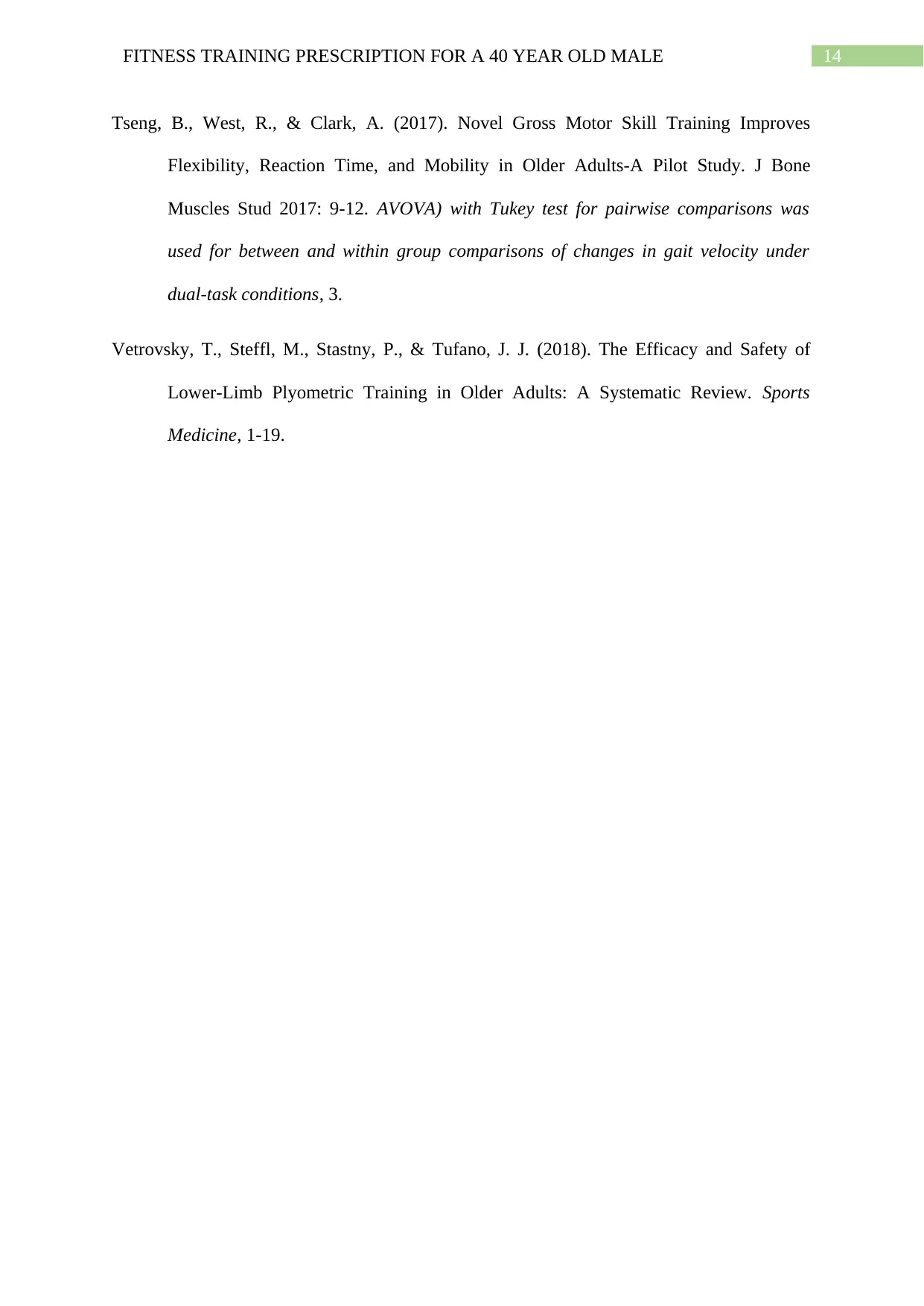
14FITNESS TRAINING PRESCRIPTION FOR A 40 YEAR OLD MALE
Tseng, B., West, R., & Clark, A. (2017). Novel Gross Motor Skill Training Improves
Flexibility, Reaction Time, and Mobility in Older Adults-A Pilot Study. J Bone
Muscles Stud 2017: 9-12. AVOVA) with Tukey test for pairwise comparisons was
used for between and within group comparisons of changes in gait velocity under
dual-task conditions, 3.
Vetrovsky, T., Steffl, M., Stastny, P., & Tufano, J. J. (2018). The Efficacy and Safety of
Lower-Limb Plyometric Training in Older Adults: A Systematic Review. Sports
Medicine, 1-19.
Tseng, B., West, R., & Clark, A. (2017). Novel Gross Motor Skill Training Improves
Flexibility, Reaction Time, and Mobility in Older Adults-A Pilot Study. J Bone
Muscles Stud 2017: 9-12. AVOVA) with Tukey test for pairwise comparisons was
used for between and within group comparisons of changes in gait velocity under
dual-task conditions, 3.
Vetrovsky, T., Steffl, M., Stastny, P., & Tufano, J. J. (2018). The Efficacy and Safety of
Lower-Limb Plyometric Training in Older Adults: A Systematic Review. Sports
Medicine, 1-19.
1 out of 15
Related Documents
Your All-in-One AI-Powered Toolkit for Academic Success.
+13062052269
info@desklib.com
Available 24*7 on WhatsApp / Email
![[object Object]](/_next/static/media/star-bottom.7253800d.svg)
Unlock your academic potential
© 2024 | Zucol Services PVT LTD | All rights reserved.





